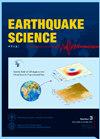基于波形叠加的四川盆地南部微震定位方法性能评价
IF 4.1
4区 地球科学
Q3 Earth and Planetary Sciences
引用次数: 0
摘要
震源位置可以表征震源的时空分布,为地震灾害监测、断层活动性表征和裂缝发育解释提供重要的基础数据。基于波形叠加的定位方法通过多通道波形聚焦源能量来反转源位置,并且这些方法具有高水平的自动化和抗噪声性。本文以互相关叠加(CCS)方法为例,尝试研究基于波形叠加方法的影响因素,提出了一种基于多参数、多指标的综合性能评价方案。波形资料来自四川盆地南部长宁地区诱发微震活动的野外监测。综合和现场数据测试揭示了三类因素对基于波形叠加的定位的影响:速度模型、监测阵列和波形复杂性。从源成像分辨率和定位误差两方面对定位性能进行了评价和进一步改进。密集阵列监测有助于更好地约束震源深度和定位可靠性,但速度模型不确定性和多地震相等多种因素的综合影响增加了现场微震事件定位的复杂性。最后,对定位不确定性、相位检测和基于人工智能的定位进行了讨论。本文章由计算机程序翻译,如有差异,请以英文原文为准。
Performance evaluation of the waveform stacking-based microseismic location method in the southern Sichuan Basin of China
Seismic source locations can characterize the spatial and temporal distributions of seismic sources, and can provide important basic data for earthquake disaster monitoring, fault activity characterization, and fracture growth interpretation. Waveform stacking-based location methods invert the source locations by focusing the source energy with multichannel waveforms, and these methods exhibit a high level of automation and noise-resistance. Taking the cross-correlation stacking (CCS) method as an example, this work attempts to study the influential factors of waveform stacking-based methods, and introduces a comprehensive performance evaluation scheme based on multiple parameters and indicators. The waveform data are from field monitoring of induced microseismicity in the Changning region (southern Sichuan Basin of China). Synthetic and field data tests reveal the impacts of three categories of factors on waveform stacking-based location: velocity model, monitoring array, and waveform complexity. The location performance is evaluated and further improved in terms of the source imaging resolution and location error. Denser array monitoring contributes to better constraining source depth and location reliability, but the combined impact of multiple factors, such as velocity model uncertainty and multiple seismic phases, increases the complexity of locating field microseismic events. Finally, the aspects of location uncertainty, phase detection, and artificial intelligence-based location are discussed.
求助全文
通过发布文献求助,成功后即可免费获取论文全文。
去求助
来源期刊

Earthquake Science
GEOCHEMISTRY & GEOPHYSICS-
CiteScore
1.10
自引率
8.30%
发文量
42
审稿时长
3 months
期刊介绍:
Earthquake Science (EQS) aims to publish high-quality, original, peer-reviewed articles on earthquake-related research subjects. It is an English international journal sponsored by the Seismological Society of China and the Institute of Geophysics, China Earthquake Administration.
The topics include, but not limited to, the following
● Seismic sources of all kinds.
● Earth structure at all scales.
● Seismotectonics.
● New methods and theoretical seismology.
● Strong ground motion.
● Seismic phenomena of all kinds.
● Seismic hazards, earthquake forecasting and prediction.
● Seismic instrumentation.
● Significant recent or past seismic events.
● Documentation of recent seismic events or important observations.
● Descriptions of field deployments, new methods, and available software tools.
The types of manuscripts include the following. There is no length requirement, except for the Short Notes.
【Articles】 Original contributions that have not been published elsewhere.
【Short Notes】 Short papers of recent events or topics that warrant rapid peer reviews and publications. Limited to 4 publication pages.
【Rapid Communications】 Significant contributions that warrant rapid peer reviews and publications.
【Review Articles】Review articles are by invitation only. Please contact the editorial office and editors for possible proposals.
【Toolboxes】 Descriptions of novel numerical methods and associated computer codes.
【Data Products】 Documentation of datasets of various kinds that are interested to the community and available for open access (field data, processed data, synthetic data, or models).
【Opinions】Views on important topics and future directions in earthquake science.
【Comments and Replies】Commentaries on a recently published EQS paper is welcome. The authors of the paper commented will be invited to reply. Both the Comment and the Reply are subject to peer review.
 求助内容:
求助内容: 应助结果提醒方式:
应助结果提醒方式:


